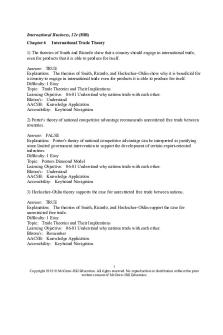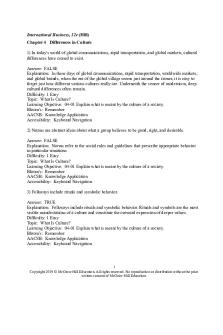Accounting TB Chapter 1 Answer key (p 12 to 16) PDF

| Title | Accounting TB Chapter 1 Answer key (p 12 to 16) |
|---|---|
| Course | Accounting |
| Institution | Indiana University Bloomington |
| Pages | 5 |
| File Size | 111.6 KB |
| File Type | |
| Total Downloads | 5 |
| Total Views | 135 |
Summary
Accounting textbook answer key for first chapter (chapter 1) going through pages 12 to 16, including short answer solutions....
Description
Name
Date
CHAPTER 1
Accounting and Business
CHAPTER 1
REVIEW QUESTIONS
(page 12)
1. The five main activities involved in accounting are gathering financial information; preparing and collecting permanent records; rearranging, summarizing, and classifying financial information; preparing information reports and summaries; and establishing controls to promote accuracy and honesty among employees.
2. Answers should include three of the 19 questions listed on pages 2 and 3 of the student textbook.
3. Owners and managers form one group that benefits from information presented by the accounting system. The other group consists of outsiders, like investors, bankers, labour unions, and government agencies.
4. Knowledge of accounting makes you more employable because there are many jobs that require accounting and clerical skills in many fields. 5. Knowledge of accounting can help business owners gain a better understanding of banking; how to keep track of amounts owed to suppliers and owed by customers; how to manage accounting records for the government; how to produce an income statement; and how to handle payroll accounting.
6. Public accountants offer their services to the general public for a fee, in the same way that a lawyer does. 7. Auditing is the examination and testing of the books, records, and procedures of a business so that an accountant is able to express an opinion about its financial statements. 8. Three kinds of business besides the service business are the merchandising business, the manufacturing business, and non-profit organizations. 9. Three forms of business ownership are sole proprietorship, partnership, and corporation. 10. An example of a routine accounting activity is recording transactions daily. An example of a periodic accounting activity is processing payroll. 11. The accounting cycle is a recurring set of accounting procedures carried out during each fiscal period. 12. Three professional accounting organizations are the Certified General Accountants Association, the Society of Management Accountants of Canada, and the Canadian Institute of Chartered Accountants.
Copyright © 2013 Pearson Canada Inc.
Chapter 1 Accounting and Business
1
Name
Date
CHAPTER 1 REVIEW QUESTIONS (continued) 13. On average, it takes about seven years of post-secondary study and work to become a professional accountant.
14. The Canadian Institute of Chartered Accountants is highly regarded because of their CICA Handbook, which is used as the standard set of rules by all accounting organizations in Canada.
15. The Canadian Institute of Chartered Accountants requires 36 months of practical experience to earn the Chartered Accountant (CA) designation. 16. Members of the Canadian Institute of Chartered Accountants, the Certified General Accountants Association of Canada, and the Society of Management Accountants are exploring a proposal to merge the three organizations. The Chartered Professional Accountant or CPA is the designation an accountant would earn after fulfilling the requirements of this new merged organization.
17. IFRS stands for International Financial Reporting Standards. 18. An accounting clerk’s work is routine and clerical in nature. 19. An accountant is responsible for all aspects of accounting. 20. Spreadsheets are used by all members of the accounting team, but they play an especially important role in the hands of accountants. Accountants are responsible for maintaining the entire accounting system, which includes planning and forecasting. Spreadsheet software allows accountants to quickly see the results of changing financial scenarios. Spreadsheets are also useful for generating charts and tables that can be used in presentations.
CHAPTER 1
REVIEW EXERCISES
(page 13)
Using Your Knowledge Exercise 1, p. 13 A. Certified General Accountants Association
H.
sole proprietor
B.
Society of Management Accountants
I.
corporation
C.
CICA
J.
public accountants
D.
financial statements
K.
auditing
E.
non-profit business
L.
service business
F.
accounting cycle
M.
manufacturing business
G.
merchandising business
2
Accounting 1 Teacher’s Key
Copyright © 2013 Pearson Canada Inc.
Name
Date
CHAPTER 1 REVIEW EXERCISES (continued) Exercise 2, p. 14 Complete each of the statements below by filling in the blank with the title accountant or accounting clerk. accounting clerk A. The work of an is clerical in nature. accounting clerk B. The work of an is concerned with routine matters. accounting clerk C. An ensures that the supporting documents are present and correct for every transaction. accountant D. An ensures that International Financial Reporting Standards are followed. accounting clerk E. An records the accounting entries in the books of account. accounting clerk F. An makes the payroll calculations. accountant G. An by the accounting system. accounting clerk H. An transactions. accountant I. An
J. A professional
accountant
prepares reports based on the data produced carries out all the necessary banking participates in management meetings. has a high-level position.
Exercise 3, p. 14 Circle the best answer to each question. A. Which of the following statements does not fit the job title? a. An accounting clerk verifies source documents. b. An accounting clerk ensures that the ledger balances. c. An accounting clerk works neatly to guard against errors. d. An accounting clerk studies tax bulletins to keep up to date. B. Which of the following statements does not fit the job title? a. An accounting clerk works out accounting entries. b. An accounting clerk, together with the owner, compares this year’s and last year’s income statements. c. An accounting clerk uses software to record accounting entries. d. An accounting clerk inquires about a suspected error made by the bank. C. Which of the following statements does not fit the job title? a. An accountant is a professional person. b. An accountant has a broad knowledge of accounting. c. An accountant ensures the accuracy of the payroll cheques. d. An accountant discusses the business’s cash flow with the owners.
Copyright © 2013 Pearson Canada Inc.
Chapter 1 Accounting and Business
3
Name
Date
CHAPTER 1 REVIEW EXERCISES (continued) Exercise 3, p. 14 (continued) D. Which of the following statements does not fit the job title? a. An accountant talks about revising a spreadsheet model. b. An accountant investigates the credit rating of a new customer. c. An accountant is promoted to vice-president. d. An accountant is ill; a meeting with the bank manager has to be cancelled. E. Which of the following statements does not fit the facts about computers? a. The computer is an ideal machine for use in an accounting environment. b. The computer can handle large quantities of data. c. The computer produces better profit figures. d. The computer can provide information for management very quickly. Exercise 4, p. 15 A. to C. Write your report on a separate sheet of paper and attach to your Workbook. Answers will vary depending on whom the students choose to interview.
COMMUNICATE IT (page 15) Attach a printed copy of your email to your Workbook. Answers will vary depending on students’ research. Students should mention the degree and work experience requirements for all three accounting designations as well as the career opportunities each one offers.
CAREER
Katie Russell/High School Student
(page 16)
Discussion (p. 16) 1. Volunteering allows you to learn new skills, have new experiences, and help people. In some cases, you can gain work experience that helps you get paid employment.
2. The accounting organizations get to introduce themselves to students who are interested in accounting and who might later consider working for these companies. They also enhance their public profile and show that they are generous members of the community.
3. There are a lot of details to remember in accounting so a multiple-choice test fits the subject. Also, multiple-choice tests are easy to mark, which cuts down on the time it will take to process all the entries.
4
Accounting 1 Teacher’s Key
Copyright © 2013 Pearson Canada Inc.
Name
Date
CAREER KATIE RUSSELL/HIGH SCHOOL STUDENT (continued) Research and Writing Questions (p. 16) 4. Answers will vary depending on the organization that is found. Students should provide details about the organization and the programs that help students learn job skills and financial literacy.
5. Answers will vary depending on the university or college that is chosen. Students should provide details about the business programs offered by the institution that require Grade 12 accounting. Students should also list other courses that are prerequisites for the programs.
Copyright © 2013 Pearson Canada Inc.
Chapter 1 Accounting and Business
5...
Similar Free PDFs

Hill12e Chapter 16 TB Answer Key
- 50 Pages

Hill12e Chapter 12 TB Answer Key
- 49 Pages

Chapter 16 (Answer Key)
- 19 Pages

Strayer Chapter 16 - answer key
- 6 Pages

Chapter 12 TAX Answer KEY
- 4 Pages

Hill12e Chapter 07 TB Answer Key
- 54 Pages

Hill12e Chapter 06 TB Answer Key
- 44 Pages

Hill12e Chapter 11 TB Answer Key
- 50 Pages

Hill12e Chapter 05 TB Answer Key
- 51 Pages

Hill12e Chapter 04 TB Answer Key
- 50 Pages

Hill12e Chapter 01 TB Answer Key
- 49 Pages

Hill12e Chapter 20 TB Answer Key
- 49 Pages

Hill12e Chapter 03 TB Answer Key
- 51 Pages

Hill12e Chapter 01 TB Answer Key
- 52 Pages
Popular Institutions
- Tinajero National High School - Annex
- Politeknik Caltex Riau
- Yokohama City University
- SGT University
- University of Al-Qadisiyah
- Divine Word College of Vigan
- Techniek College Rotterdam
- Universidade de Santiago
- Universiti Teknologi MARA Cawangan Johor Kampus Pasir Gudang
- Poltekkes Kemenkes Yogyakarta
- Baguio City National High School
- Colegio san marcos
- preparatoria uno
- Centro de Bachillerato Tecnológico Industrial y de Servicios No. 107
- Dalian Maritime University
- Quang Trung Secondary School
- Colegio Tecnológico en Informática
- Corporación Regional de Educación Superior
- Grupo CEDVA
- Dar Al Uloom University
- Centro de Estudios Preuniversitarios de la Universidad Nacional de Ingeniería
- 上智大学
- Aakash International School, Nuna Majara
- San Felipe Neri Catholic School
- Kang Chiao International School - New Taipei City
- Misamis Occidental National High School
- Institución Educativa Escuela Normal Juan Ladrilleros
- Kolehiyo ng Pantukan
- Batanes State College
- Instituto Continental
- Sekolah Menengah Kejuruan Kesehatan Kaltara (Tarakan)
- Colegio de La Inmaculada Concepcion - Cebu

